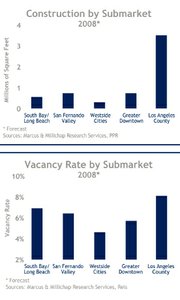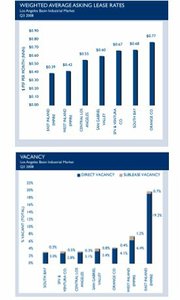California's Commercial Real Estate Slows but Outpaces Others
Despite all the turmoil in the money markets and overall pressure on the economy, California commercial real estate withstood the challenges better than most parts of the country during the third quarter.
Retail rents on average were up because of new and more expensive properties coming online during the quarter. According to data provided by Marcus & Millichap, rents in Los Angeles grew by 0.8 percent while Orange County’s advanced 1.1 percent because of landlords making concessions for tenants. In San Francisco, retail rents increased by 2.7 percent.
New projects in Los Angeles include L.A. Live! in downtown and Pacoima Plaza in the San Fernando Valley. In the Bay Area, Nike Inc. and J.Crew have opened stores at the Bay Street Emeryville mixed-use development.
Still, economic pressures, including rising unemployment rates, contributed to rising vacancies across the board. Los Angeles County vacancies ended the quarter at 8.1 percent, up 80 basis points given the formula that 1 percent is equal to 100 basis points.
Looking toward the fourth quarter, the recent wildfires will likely have a negative impact into the billions on real estate overall. A report by the University of California, Berkeley and the state of California estimated that $2.5 trillion in real estate assets are at risk from “extreme weather events” such as fires and floods.
Marcus & Millichap Managing Director of Research Hessam Nadji, speaking at the company’s Nov. 20 “Industrial & Office Outlook” conference, said the company does not see any relief until at least 2010.
“You should see a modest recovery when housing becomes less of a drag on the economy,” he said. “That will be the trigger.” Apparel Companies Buoy Industrial Market
In key industrial markets, demand declined for a second straight quarter, said researchers from Colliers International. Rents declined to 52 cents from 54 cents for industrial properties in the Los Angeles Basin—including Orange County and the Inland Empire—which realized 1.5 million square feet in negative net absorption. Vacancies on average rose to 6 percent from 4.8 percent, which is better than the 10 percent U.S. average.
Despite the downturns, the apparel industry was fairly active during the quarter, with several companies expanding into larger spaces.
Recent activity includes purchases by denim maker Robin’s Jeans, which paid $2.4 million for a 22,000-square-foot office/warehouse in Bell Gardens, Calif., near Vernon.
O’Neill Clothing, which operates under the La Jolla Group Inc., doubled its previous space by leasing a 200,000-square-foot building located off Interstate 5 and Jamboree Boulevard in Irvine, Calif.
La Jolla has the licenses to manufacture O’Neill as well as Rusty, Lost Clothing and Metal Mulisha.
“Our new work environment includes space that is not only functional but productive,” said Chief Executive Officer Toby Bost, adding that the building features a distribution center, retail concept store, fitness center and 6,000-square-foot conference center and showroom.
Other tenants in the immediate area include Billabong, Volcom and C&C Inc.
Streetwear brand L.R.G. (Lifted Research Group) also was on the move, leasing a new 91,000-square-foot center in Irvine, not far from Oakley’s massive headquarters. LRG previously operated out of a 70,000-square-foot building in Lake Forest, Calif.
Robin’s Jeans previously occupied three stories in a garment building on Los Angeles Street in the Fashion District. Now, all operations—including design, manufacturing, warehousing and sales—are under one roof in Bell Gardens.
“It’s much more convenient. We manufacture everything in L.A. We started three years ago, and people are starting to notice our jeans,” said owner Robin Chretien, who, before starting his own line, was the chief designer for Blue Cult. Robin’s Jeans includes men’s, women’s and children’s denim, and all feature wing embroidery on the back pockets.
Chretien said he made the move to buy rather than lease because of the investment potential and the fact that he plans to be in business for a long time.























